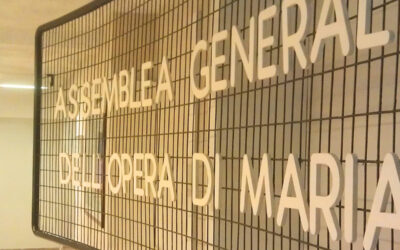 Everything began twenty years ago from one of the members of the parish, who was visited by a group of Romani children who insistently asked him to go and see the image of the Madonna in their neighbourhood that, according to them, cried. This was the first contact with the Rom community, and which led to some of the parishioners gathering together everyday to pray in this square together with the children. Despite a series of initiatives started together successfully, after two years the prayer group was dissolved; and it took ten years so that they could start the journey together once again. It was the Prayer and Mission Group “Ceferino Jiménez Malla” that gave the go signal, to meet every Monday to pray at the Grotto of Our Lady of the Valley, at the center of the square of the Rom neighborhood. «We had to overcome fear, prejudices, indifference, a refusal that was born from a wrong relationship with them,” Maria Teresa Sosa, volunteer of the Focolare Movement, shared, “but then the barriers fell, and we discovered that the Rom love to listen to the Word of God since, most of them are illiterate.” Then other members of the Focolare joined our group. “The experience would like to create a relationship through simple gestures of reciprocity, continued Maria Teresa, “to get to know each other by name, look at each other in the eyes, listen to one another, making ourselves one with the other. For example, to celebrate the birth of a child, or to visit patients in hospital. One of them was administered with the Sacrament of the Sick”. We also look for ways of inculturation, translating into prayers such as the Our Father, Hail Mary, or the Glory be into the Roma language. “When they listen to us pray the children say: ‘You are like the Rom’.” Another important step was that of celebrating together the International Romani Day, which they didn’t know about, so as to give visibility to the community. A journey continues, on the 8th of April every year also thanks to the media: the Rom community will participate regularly in a transmission on Radio Maria wherein they will share about their customs, a newspaper published a page on the experiences of the Rom Mission. The visibility that they gained allowed them to start a project to provide literacy in collaboration with an Teaching Institute of formation.
Everything began twenty years ago from one of the members of the parish, who was visited by a group of Romani children who insistently asked him to go and see the image of the Madonna in their neighbourhood that, according to them, cried. This was the first contact with the Rom community, and which led to some of the parishioners gathering together everyday to pray in this square together with the children. Despite a series of initiatives started together successfully, after two years the prayer group was dissolved; and it took ten years so that they could start the journey together once again. It was the Prayer and Mission Group “Ceferino Jiménez Malla” that gave the go signal, to meet every Monday to pray at the Grotto of Our Lady of the Valley, at the center of the square of the Rom neighborhood. «We had to overcome fear, prejudices, indifference, a refusal that was born from a wrong relationship with them,” Maria Teresa Sosa, volunteer of the Focolare Movement, shared, “but then the barriers fell, and we discovered that the Rom love to listen to the Word of God since, most of them are illiterate.” Then other members of the Focolare joined our group. “The experience would like to create a relationship through simple gestures of reciprocity, continued Maria Teresa, “to get to know each other by name, look at each other in the eyes, listen to one another, making ourselves one with the other. For example, to celebrate the birth of a child, or to visit patients in hospital. One of them was administered with the Sacrament of the Sick”. We also look for ways of inculturation, translating into prayers such as the Our Father, Hail Mary, or the Glory be into the Roma language. “When they listen to us pray the children say: ‘You are like the Rom’.” Another important step was that of celebrating together the International Romani Day, which they didn’t know about, so as to give visibility to the community. A journey continues, on the 8th of April every year also thanks to the media: the Rom community will participate regularly in a transmission on Radio Maria wherein they will share about their customs, a newspaper published a page on the experiences of the Rom Mission. The visibility that they gained allowed them to start a project to provide literacy in collaboration with an Teaching Institute of formation.  But the bridge must also be created also on the side of the Argentinian community: in a secondary school that is found near the gypsies and with whom they have no relationship at all, a teacher tackled the topic of prejudice towards ethnic minorities, while some journalism students made a report entitled “Creoles and Rom, the start of a dialogue” (in this context the term “creoles” refers to the Argentinians). In March, at the start of the school year, a project began to save seats in the classroom for Romani children, who are often discriminated, and group participated in the day of their welcome into the school. There are many initiatives, from sewing lessons for the girls to catechism for the children, and it would be impossible to name all of them that are being done in this place. “Our desire,” she concluded, “is to create a national network of bridge.” On June 5 and 6, Maria Teresa is in Rome for the worldwide Meeting of the episcopal promoters and the national directors of Pastoral work among the gypsies, upon th einvitation of Cardinal Vegliò, president of the Pontifical Council of Itinerants and Migrants.
But the bridge must also be created also on the side of the Argentinian community: in a secondary school that is found near the gypsies and with whom they have no relationship at all, a teacher tackled the topic of prejudice towards ethnic minorities, while some journalism students made a report entitled “Creoles and Rom, the start of a dialogue” (in this context the term “creoles” refers to the Argentinians). In March, at the start of the school year, a project began to save seats in the classroom for Romani children, who are often discriminated, and group participated in the day of their welcome into the school. There are many initiatives, from sewing lessons for the girls to catechism for the children, and it would be impossible to name all of them that are being done in this place. “Our desire,” she concluded, “is to create a national network of bridge.” On June 5 and 6, Maria Teresa is in Rome for the worldwide Meeting of the episcopal promoters and the national directors of Pastoral work among the gypsies, upon th einvitation of Cardinal Vegliò, president of the Pontifical Council of Itinerants and Migrants.




0 Comments